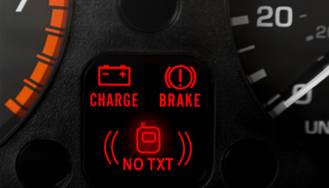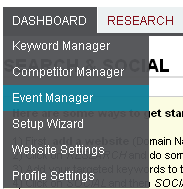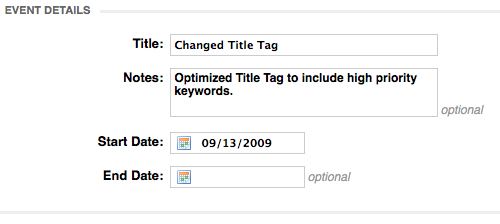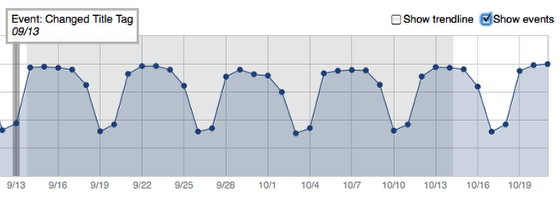- Google Brings Google Mobile App to Your iPad
- Google Releases Official Buzz Share Buttons
- Weekly Search & Social News: 04/13/2010
- When (Not) To Use Target="_Blank" Link Attribute
- How Texting and Driving Could Destroy Your Business [With Legal Analysis]
- Track Your Page Change with SEJ Tools "Event Manager"
- Suddenly Twitter Has a Business Model, Tweet Ads
- More Recent Articles
- Search Search Engine Journal
It pains me to cover anything iPad-related news right now as I’m having a rough experience with our local FedEx Broke which has been “detaining” my iPad for a couple of days now. But in the spirit of reporting, I have to forget about this issue and cover this Google-iPad related news. So, here we go, Google just announced that its
Google Mobile App for iPad is now available for free download from the iPad App Store.
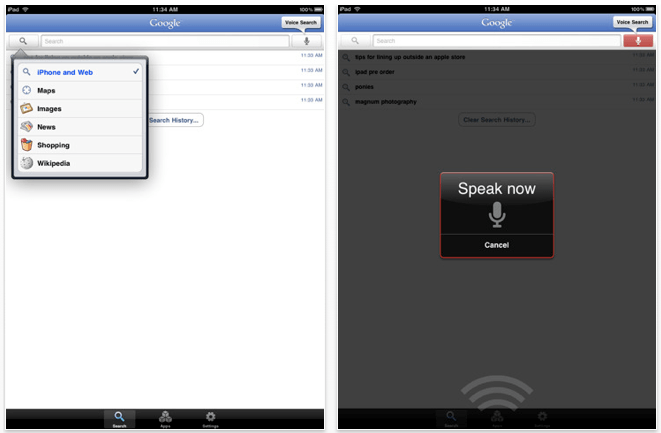
If you have previously used Google Mobile App on your iPhone, it’s basically the same app, only this time it was tweak a bit to fit into the iPad interface. The new
iPad-friendly Google Mobile App features practically everything that you’ve enjoyed in the app’s iPhone version.
The app features several search-related functionality including – search by voice, Google suggest, search history, contact search and vertical search. In addition, the app also recognizes your current location. This useful when you are searching for nearby location while on the move. The app also lets you navigate to Google’s web-based apps including Gmail which incidentally was also optimized for the iPad.
Coming up are new features that will take advantage of the iPad’s features. To download Google Mobile App for iPad, check out the iPad App Store.
Check out the
SEO Tools guide at
Search Engine Journal.
Google Brings Google Mobile App to Your iPad



Google’s next order of battle for Google Buzz – Share Buttons. If you’ve felt envious of sites such as TechCrunch and Mashable which were quick enough to come up with their customized Google Buzz Share Buttons, Google will now let you do the same without having to hack through some codes and all. And it’s also the official Google Buzz Share Button.
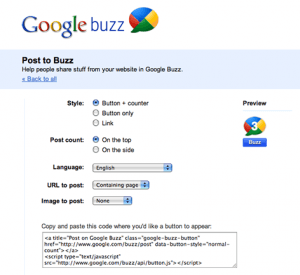
So
Google announced that starting today expect to see Buzz buttons around the web particularly on sites such as The Huffington Post, Glamour, YouTube, Blogger, MySpace, GigaOM and more. These buttons will make it easier for you to share and post interesting items you encounter around the web to your Google Buzz account.
In addition, independent sharing widget provides such as “Share This,” “Shareholic” and more have started implementing the Google Buzz share button.
If you want to have a Google Buzz button on your own sites/blogs, you can easily do so by getting the codes from
buzz.google.com/stuff. You can customize your button in a few clicks, copy the Javascript code, paste it to your blog/site code and you’re good to go.
And while you’re there, you might also want to grab the code for putting a follow me on Buzz button as well. This will make it easier for your friends and fans to follow your Buzz posts.
Check out the
SEO Tools guide at
Search Engine Journal.
Google Releases Official Buzz Share Buttons



Welcome to another edition of ‘
7 Days of Search and Social‘ – I hope it finds you well. It was a somewhat quite week on the blog goodiness last week, but there were a TON of patents from the big three…which makes this geek all giddy. The main story, for what it’s worth, was Google announcing the load speed signal. On a personal level, being a Canuck and all, the weather is picking up which also has be smiling…
Anyway, let’s get into it shall we?
Lead Story
Run for the hills load speed is here!
Or at least that is some of the perceptions we're soon to hear. You see, late last week
Google finally confirmed what we'd been expecting; that page load speed is a ranking signal. I can already see the spate of crap hat SEOs that will be touring this and of course offering corresponding services.
Here's some goodies;
Now, it really does bare mentioning that there are a LOT of signals that Google uses in their rankings that we don't go too far out of our way to optimize for… What I like to call; Task ROI. What this means now, is that we also need to consider this when we're looking at this one.
From what we know, it would be the extreme situations (horrid load times) and select query spaces where this is more important. I wouldn't go about re-developing an entire site unless you are in the bottom 10% in a given space. There are still better things to be doing (from an SEO perspective) than this.
All of that being said, it is still good webmastering, and worth at least looking into. Just don't get too crazy, m'kay?
| DIY SEO Software Reviews – Aaron Wall looks at the new service recently started by Patrick Gavin and partners. It is what it is… not a replacement, but potentially useful for those in the low end budget world or noob webmasters. (haven't checked it out myself). |
| Eight Emotional Stages of an SEO Contract – ok, who needs a good laugh? I must say, while not geeky, I did get a heluva laugh from Alan. Thanks brother, your pain was my giggles. |
| Wake Up Suzy – Wake Up! – Managing SEO Client Expectations – as a sister post, Alan also had a more serious post on dealing with clients. This is a GREAT topic and one that we don't usually see enough of. A good read. |
| Why big brands need SEO - Speaking of clients, obviously Kevin isn't working with MacDonald's. In this post he uses them as an example of why brands should be doing better with SEO…and gives some good examples. |
| Report: Some Google 'Hot Topic' Searches Return 90% Malicious Links – is some interesting reporting from Barry over on SER. Kind of shitty really… yet another reason why spammy crap hats piss me off. Nuff said. |
| Survey Results: The Most Annoying Part of Search Marketing – the gang at WordStream posted some results of a survey they recently ran. Not surprisingly, link building still tends to be one of the areas a lot of people struggle in. |
| Forecasting Seasonality for SEO Campaigns – this one I also found interesting as I've been research universal search, which is somewhere we see a LOT of movement from seasonal flux. A worthy addition to this week's editon. |
| Google secretly tests feed of hotel room prices in natural search results – speaking of universal, there were some interesting additions to the hotel space noted last week. Something we may see in other local and ecommerce query spaces. |
| Rankings are not (that) important – CJ continues a recent discussion making the rounds about the value of rankings in modern SEO. I tend to be somewhat more in-line with her thinking, that they may not be a KPI, but do still hold value. |
| Link Building for Image Rich Websites – is a great post from link geek master Wiep Knol. This journey is an interesting approach for a market one might not always think about. A good addition to the newsletter this week… |
| Surviving a Site Migration [An SEO's Guide] – this is one area that is VERY important. Doing a site migration can cause a TON of problems when not done right. A good round up of potential areas of interest… Read it, learn it.. master it! You will need it some day. |
/end SOSG session
Check out the
SEO Tools guide at
Search Engine Journal.
Weekly Search & Social News: 04/13/2010



More and more sites are using target=”_blank” for links to make sure they will open the link in a new window and keep the visitor on the site.
I confess, I am using them myself because I assume the visitors are using FireFox browser that opens those links in a new window.
But is it really a wise thing to do?
When Target=”_Blank” Can / Should Be Used
There is the fundamental law of the Internet ethics that says that you
let the visitor decide how he wants to open the links. So (especially) when your target audience consists of technically sophisticated users (like SEO audience for example), be warned that they do not like new windows. They also know how to open a new window or how to prevent a new window whenever they want.
The cases when the attribute can (and is encouraged to) be used are the following:
- To link to a PDF document mostly because when it’s first followed there’s often a delay while the browser loads up the plugin and PDF (and thus you can let the visitor read more information on the current page while the document loads).
It is also a wise thing to do to warn the visitor of the type of the file he is going to download and how the link will open:
Document (PDF 13K, new window)
- To link to “supplemental information” like help files or additional information that would ordinarily clog up the topic with tangent data.
Target=”_Blank” Versus Other Ways to Open Links in a New Window
JavaScript methods versus “target=”_blank”
-
Target=”_blank” will always open a new window or tab exactly the same size as the original, covering up the original and can be extremely confusing, especially if the user clicks and looks away for a moment. With a Javascript method, you can control the size of the window so that’s it’s VERY obvious it’s a new window and you can still see the parent behind it.
- Obviously, JavaScript method won’t work if JavaScript is disabled. Besides, it will prevent the search bot from crawling the page.
Target=”_blank” versus Target=”new”
Here’s an awesome explanation: Using
_blank as a target value will spawn a new window every time while using
_new will only spawn one new window and every link clicked with a target value of
_new will replace the page loaded in the previously spawned window. Try it out for yourself:
Links with target="_blank"
Google |
Yahoo
Links with target="_new"
Google |
Yahoo
Additional reading:
Check out the
SEO Tools guide at
Search Engine Journal.
When (Not) To Use Target=”_Blank” Link Attribute



Did the title of my post get your attention? Believe me, I wish texting and driving couldn't destroy your business, but it unfortunately has the potential to. In this month's post, I'm taking a break from writing about technical SEO, Paid Search, Social Media Marketing, etc. to talk about something that can make even your worst search-related problem look like a walk in the park.
Last week I was driving on 95 behind a car that suddenly started to swerve from the middle lane to the left lane, and then back across to the right lane. After a minute or so behind the person, I decided to pass the car to get away from the problem. As I passed the car, I glanced over and saw the driver on his mobile phone. He was typing, so he was either texting someone, emailing someone, or maybe even checking Twitter. I don't know about you, but experiencing that first hand on 95 at a relatively high rate of speed really brought home the danger of texting and driving. It would only take a split second for that person to slam into another car and possibly cause a fatal accident. And for what? To check the latest retweet or DM?
No Shortage of Examples, With Statistics to Back Up The Problem
You don't have to look far to read about tragedies that resulted from texting and driving. For example, a
47 year old woman who ran a red light while texting and driving and struck an SUV carrying a family of four (killing two people, a 4 year old girl and her 35 year old mother). Or how about a
19 year old who was texting and driving and caused another car to spin out of control (killing two men, 38 and 50 years old). Or the story of Sam Page,
whose sister slammed into a telephone pole and died as they were texting back and forth. The list of stories goes on and on…
In addition to the heartbreaking stories, the statistics about the effects of texting and driving are mind-blowing. For example, a
study by the Viginia Tech Transportation Institute (PDF) found that drivers who text and drive are
23.2 times as likely to be involved in a crash or near crash event than non-distracted drivers. In addition,
Car and Driver ran a test of their own, showing the delay in reaction time and how much further a driver traveled beyond the point they should have stopped when texting and driving. The reaction time for both a 22 year old and 37 year old while texting and driving were worse than being impaired by alcohol. They also traveled 31 feet and 319 feet further than they should have when texting and driving at 70 mph. Imagine the damage you could do if you needed to stop at one point, but ended up traveling another 319 feet!
Although the concept of texting and driving is relatively new, the abundance of disturbing cases has pushed some states to act. You can check out
txtresponsibly.org to view the
states have passed laws against texting while driving and there's even a recent push against truckers and texting (which obviously makes complete sense). But as we all know, there's a difference between passing legislation and actually changing driver behavior.
The Business Impact of Texting and Driving
I think most of us clearly understand that you can either kill other people or kill yourself when texting and driving. That's obviously the worst case scenario, but there is another dangerous aspect of getting into an accident from texting (although not as grim as killing someone or being killed). I'm referring to the potential business impact.
Let's say that you get through an accident relatively unscathed. Maybe you just end up with some minor injuries and the other people involved are still alive (although their cars are damaged and they possibly have a broken bone or two). Are you really out of the woods? What's the potential impact for you
professionally? What can happen to the business that you worked tirelessly to build, the job you've been working 70 hours a week for, and your reputation? Unfortunately, in our litigious society you're far from being out of the woods. Instead, you can find yourself neck deep in the woods. And the woods I'm referring to aren't filled with furry little bunnies and cute woodland creatures. Instead, the legal woods are filled with rabid lawyers, judges who don't like young punks with iPhones, and people looking to take advantage of our legal system. Yes, welcome to America.
Business Owners Take Heed
If you are a consultant, run your own business, run an agency, or if you're an executive at a company, you need to address the problem of texting and driving now (before you're neck deep in the scary woods I just mentioned). And by the way, this also relates to your employees and not just your own behavior. On the flip side, if you're an employee at a company and have a company-issued cell phone, you should also listen up. The legal system is a two way street, and you can also find yourself in court. More on that below.
Texting While Driving, A Legal Perspective
Last year I wrote a post titled, "
Lawyers, Guns, and Twitter: Who Owns Your Twitter Account?" which addressed social media account ownership. In the post, I introduced various scenarios along with my view of who actually owned the accounts created and managed by employees. I gave my perspective as an online marketer and then I asked a lawyer I know from Princeton (
Mike Pisauro) to review the scenarios and give his input from a legal-standpoint. Needless to say, we didn't see eye to eye on all the topics. :) I decided to use a similar format with this post. I'm going to list several potential business scenarios regarding texting and driving and then have Mike give his legal view.
So without further ado, let's get started.
Scenario 1: The Owner of the Business Causes an Accident By Texting and Driving
Let's say you run your own business, and like most business owners, you have a mobile phone that's used mostly for professional use (although you do receive personal calls, text messages, and emails on the phone). You ended up emailing back and forth with a client while on the road since there was a big project underway. As you were looking down to send that last email, you rear-ended a minivan with a family of 4 inside. You hit them at 50 mph and there were several injuries. You can forget about that client for now, since you've got bigger fish to fry. So, what can happen as a result of the accident? Can your business be sued? Can you be sued personally? How about both? Are criminal charges possible? This is where I'll hand it off to Mike for his input.
Mike: I have to agree that texting/emailing, tweeting, etc. while driving is dangerous and prevalent and we have all seen drivers all over the road while trying to do something on their phones. It can also have a profound impact on an employer. I will preface all of my answers with a few caveats. First, like many things in law some of the answers to these questions depend on where you live or in this case where the accident occurs. I practice in NJ and in PA but that does not mean that a Maine judge will treat each scenario exactly the same way as a NJ judge. For some of these scenarios, we need more information to make a full evaluation of the merits of each case. I am assuming for each of these scenarios that there was not a company policy against using a smartphone while driving. I am also assuming that the motor vehicle was owned by the employee/owner personally and was not a company car. I am also assuming that the employee is really at fault for the accident.
There can be several different theories of liability for the company that I would probably look into and try to assert in a complaint against the driver and their employer. For this post, I have decided to apply the theory of respondeat superior. i.e. can the employer be liable for the actions of its employee. I am not looking at whether the employer or another particular employee could be liable for causing a distraction to the driving employee. I am not sure that issue has ever been decided by a court in a reported decision. Assuming the theory of liability would be allowed by the Courts, it is too fact specific and jurisdiction specific for easy analysis (and the blog post would be even longer than it is now). I decided to go with respondeat superior because it is almost universally accepted and would be a much easier case for the plaintiff's lawyer to pursue.
With the caveats out of the way, this scenario is very clear. From the get go the business owner will be personally liable for the damages to the car and to the people. It is a basic tenant that a person who commits a tort (causes an accident) is personally liable for that tort. I think that in most, if not all jurisdictions, the business in this situation can be sued as well. I will explain my reasoning for this decision in one of the scenarios below.
Whether the individual can be charged criminally for the accident really depends on too many factors. Criminal law is very state specific. For example in NJ, traffic offenses are quasi-criminal. The anti-texting law in NJ makes it a traffic offense subject to a $100 fine. Other states may differ depending on their statutes. There are 7 states that have bans on talking on cell phones while driving without a hands free system. There are 21 states that ban texting. In addition to state laws, there can also be local laws impacting the use of cell phones while driving.
http://www.iihs.org/laws/cellphonelaws.aspx. Also the severity of the injuries could also impact whether criminal charges are asserted by the State.
Scenario 2: An Employee of Your Business Causes An Accident and Injures Other People
In this scenario, your employee is not injured after having the accident. It's the person he hit that's in bad shape. Let's say the person he hit is in critical condition as a result of the accident. To make matters worse, the person that was hit runs her own business and is the primary source of income for her family (she has a husband and three kids). It ends up that she doesn't have short term or long term disability either. What if this person sues your employee? Can the employee then sue you since he was emailing you on his way home about company business? Will the insurance company decide to forgo a settlement and come after the business instead? Again, good questions and Mike is ready to answer them.
Mike: Both the driver/employee and the employer will be named as defendants. If the plaintiff's lawyer does not know initially about the employer, they will be named eventually. Also, if the employer is not named by the Plaintiff than the employee could file a third party complaint to bring the employer as a third party defendant in order to avail themselves of the business' insurance coverage. Both the employee and the employer normally would have insurance to cover the accident. Both insurance policies will normally be available to help satisfy any judgment against the defendants. In most cases the insurance company will defend the defendants and will not disclaim coverage. If the Plaintiff's injuries are substantial enough or the defendants did not have adequate coverage; the Plaintiff would then seek to recover the excess judgment personally from the employee and the employer. The recovery could be in the way of levying wages; seizing bank accounts; or selling of assets like homes, office buildings and equipment.
Even though the employer will be named as a defendant the question really is should the employer be liable for the accident. There are at least two legal tests to determine whether an employer should be liable for the actions of its employees: (1) enterprise theory followed by California and (2) Restatement (Second) of Agency followed by NJ and many other jurisdictions. California's enterprise theory is more expansive than the Restatement. Under the majority rule (or the Restatement) the question of whether an employer should be liable for the actions of its employee that causes an accident is whether the employee was acting with the scope of the employee's employment at the time of the accident. A Court would look at the following factors in deciding whether the employee was acting on the behalf of the employer at the time of the accident:
- is it the kind of work they are employed to do
- was it within the regular location and time of employment
- was the work to benefit the employer
- whether employer has reason to believe that the alleged act would be done
- whether the act was similar to authorized acts
- whether the activity was done through equipment provided by the employer
- whether the act was criminal in nature
The above criteria are some of the questions a court would seek to answer. Different courts in different jurisdictions may weigh the criteria differently. Also, there is no requirement that all of the criteria need to be satisfied. For example, I do not believe that the Court would care whether the smartphone was employer provided or owned by the employee in finding the employer liable for the actions of the employee in this scenario. In looking at this fact pattern many of the criteria are answered in the affirmative. It is clear that the employee was within the kind of work they were employed to do. It is an employee's responsibility to answer their employer's questions and email/texting is a very common method of accomplishing this. As an example of something not work related, the accident happened because the employee was eating dinner on the way home.
The question of whether the act (texting while driving) was within the time and place of employment is murkier, but I think that question would be answered in the affirmative by a court. The employer expected to be able to reach their employees 24/7 and provided the technology to accomplish that goal. It is part of the search industry and many others to use computers and smartphones to accomplish projects and this frees the employees to work in any location: the office, the coffee shop, at home or by the pool.
Since the employee was answering questions posed by the employee's boss the act was clearly to benefit the employer. (I am assuming that the questions were work related not personal in nature).
Clearly since the employer provided smartphones to the employees and expected to be able to reach the employee 24/7, the employer should clearly have reason to believe that its employee would respond to emails. The smartphone was provided by the employer so this clearly satisfies the criteria that the equipment be provided by the employer.
As noted above, texting while driving is not criminal or at least not in NJ so this escape would not apply. Texting may be against the law but it is not a crime to do so in NJ.
In the end, the employee will be found liable for the Plaintiff's injuries. You are always responsible for your torts. It is also very likely that the employer will be found vicariously liable for the actions of its employee.
Scenario 3: A Contractor You Hired Causes An Accident By Texting and Driving
Let's say you end up hiring a contractor for a short period of time to help with a spike in work. The contractor is not an employee of your company, does not have a company-issued mobile phone (from your company), although he does have his own mobile phone that's used for work. If that person causes an accident when texting or emailing you about a project while on the road, can you be liable? Can the contractor come after you personally or your company even though he's not an official employee? Let's hear what Mike has to say.
Mike: This is a much harder question to answer than the ones above. By definition, an independent contractor is not an employee. There are several factors to determine whether a person called an independent contractor is really an independent contractor and not an employee. That discussion is for another article. The Courts must decide, before looking at the criteria noted above, that the person is really the servant of the company. "Servant" can have a broader reach than mere employee. Assuming that the person is really an independent contractor, the Courts probably would not look any further, without more facts, and determine the company is not liable.
But for arguments sake, assume the Court goes further into the analysis. In this scenario, it is not clear that the company could expect the independent contractor to email the company while driving. There is nothing in the fact pattern to suggest that the independent contractor was responding to a request from the company or that the company had an expectation of instant responses. The independent contractor was using their own equipment as you would expect an I.C. to do. Therefore, the equipment criterion is not met. While the scope of work the contractor was performing is not clear, I am assuming it is one that could include emailing. There is nothing in here to suggest that the email was for the purpose of furthering the employers' business. In short, this could be a hard sell for a lawyer to convince a judge that the company should be liable for the actions of its independent contractor.
As to who would sue who, it is more likely that the plaintiff's attorney would sue the company than the contractor would sue the company. If the relationship between the contractor and the company is known to the plaintiff's attorney, the company will be named as a defendant. But being named as a defendant is not the same thing as being liable for the accident. The Plaintiff will still have to prove that company should be liable for the actions of the contractor.
Summary: Think Twice Before Texting While Driving (And Prepare Your Business Now)
I hope this post didn't scare you too much, since that wasn't my intent. The topic is obviously an important one on several dimensions, especially as mobile devices get more robust and our cars come equipped with more functionality. As Mike explained, there is a lot of grey area involved with the scenarios presented in the post. That said, it's best to prepare for the worst BEFORE anything happens. You don't want to have to deal with the scenarios listed above on the fly. Just like with my post about Twitter account ownership, instituting an employee policy setting the expectations of the employer on emails, texts and telephone calls in general, and while driving, is a strong idea. Then the policy has to be enforced, because a policy that is ignored more than it is upheld is not worth the paper that it was written on. While a good policy may not protect you at all times from liability to third parties, it will at least help in defending your company.
So the next time you're on the road and you hear that message arrive on your mobile phone, think twice about checking it. You might just end up in a hospital, in jail, or in the dark scary woods with rabid lawyers. I don't know about you, but those places don't sound very fun to me.
Check out the
SEO Tools guide at
Search Engine Journal.
How Texting and Driving Could Destroy Your Business [With Legal Analysis]


![Rate 'How Texting and Driving Could Destroy Your Business [With Legal Analysis]'](http://www.feedblitz.com/v1.asp?url=http%3a%2f%2ffeedproxy.google.com%2f%7Er%2fSearchEngineJournal%2f%7E3%2fnfm_fVYOXaA%2f)
One of the cool features inside
SEJ tools is
Event manager that lets you track your site changes and the subsequent effect more efficiently.
The Event Manager is available by hovering your mouse over the
Dashboard tab and clicking on
Event Manager.
To create a new event, click “Add event” and provide the following information:
- Your event title;
- Your event description;
- The date of the event.
Let’s say we have changed the title tag of the page and want to track the effect:
Once you’ve clicked on the Add Event button you will be taken to the main Event Manager page containing all of your events. From there, you can tag, edit, or remove any of your events. You can add numerous events – there is no limit.
For example, if you tagged any of your events you are able to display your events in analytics by their assigned tag.
After some time passes, head over to Google Analytics tab inside your SEJ Toolset dashboard (if you have previously
connected your Google Analytics to your SEJ Tools account) and see the stats changes after your event.
If you hover over your event, you are able to see a display with a description. You also have the option of turning your events off or on:
Check out the
SEO Tools guide at
Search Engine Journal.
Track Your Page Change with SEJ Tools “Event Manager”



Twitter is about to unveil something that it hopes will finally answer the grandstanding question of whether Twitter can actually make money, and if yes – how? The new Twitter business model will rely on “
promoted tweets,” which will put ads on Twitter’s search results and user feeds on Twitter.com as well as third-party Twitter clients later.
So, if you’re using TweetDeck and other mobile and desktop Twitter apps, expect to see some ads pop out along side tweets you monitor daily. Twitter’s “promoted ads” will first appear only on searches that were conducted on its website.
When this ad system is rolled in a few hours from now, expect a single ad appearing at the top of a search you conducted on Twitter. This ad takes the form of an ordinary tweet so be careful when retweeting or replying back as you may not notice that a tweet is coming from Twitter’s ad model.
For its initial run, Twitter’s promoted tweets got Starbucks, Bravoa nd Virgin America. All these companies are heavy Twitter user and use the service as their communication medium
“We wanted to do something that just enhances the conversation that companies are already having with their customers on Twitter,” said Twitter Chief Operating Officer Dick Costolo.
So, what’s your take on this? Can Twitter manage to pull one off and finally become a money generating machine?
Check out the
SEO Tools guide at
Search Engine Journal.
Suddenly Twitter Has a Business Model, Tweet Ads



More Recent Articles









